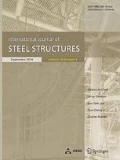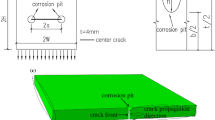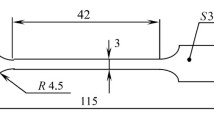Abstract
Fatigue cracks initiated from corrosion pits have been reported in various metallic structures under corrosive environments. Pit-to-crack transition occurs when the stress conditions around a corrosion pit exceed the endurance limit of the material. The effect of stress concentration at the site of a hemi-ellipsoidal corrosion pit on a metal plate was investigated using rigorous finite element analysis. Pit configuration and plate thickness were major parameters determining stress concentration factors (SCFs). Pit configuration and plate thickness were parameterized and the effects of each as a SCF were investigated. An increasing monotonic trend was evident as the pit became narrower and deeper. The effect of pit configuration was negligible, however, when the pit depth approached the plate thickness. Based on variations in the SCFs, parametric equations were developed via nonlinear regression analysis. The equations aptly represented each of the parameter characteristics and were used to accurately estimate their effect as a SCF.

(partially reproduced from ASTM (2013))













Similar content being viewed by others
References
Ahn, S. H., Lawrence, F. V., Jr., & Metzger, M. M. (1992). Corrosion fatigue of an HSLA steel. Fatigue and Fracture of Engineering Materials and Structures, 15, 625–642.
Albrecht, P., & Naeemi, A. H. (1984). Performance of weathering steel in bridges. NCHRP Report 272, Transportation Research Board, Washington, DC.
ASTM. (2013). ASTM Standard G46-94: Standard guide for examination and evaluation of pitting corrosion. West Conshohocken, PA: ASTM International.
Bannantine, J. A., Comer, J. J., & Handrock, J. L. (1990). Fundamentals of metal fatigue analysis (Vol. 90). Englewood Cliffs, NJ: Prentice Hall.
Cerit, M., Genel, K., & Eksi, S. (2009). Numerical investigation on stress concentration of corrosion pit. Engineering Failure Analysis, 16, 2467–2472.
Chen, G. S., Wan, K.-C., Gao, M., Wei, R. P., & Flournoy, T. H. (1996). Transition from pitting to fatigue crack growth—Modeling of corrosion fatigue crack nucleation in a 2024-T3 aluminum alloy. Matererial Science and Engineering, A219, 126–132.
Cook, R. D., Malkus, D. S., Plesha, M. E., & Witt, R. J. (2002). Concepts and application of finite element analysis (4th ed.). New York, NY: Wiley.
Dassault Systemes. (2016). Abaqus 2016. Providence, RI: Dassault Systemes Simulia Corp.
Eubanks, R. A. (1954). Stress concentration due to a hemispherical pit at a free surface. Journal of Applied Mechanics, 21, 57–62.
Fujita, T., & Sadayasu, T. (1978). Stress concentration due to hemispherical pit at a free surface of a thick plate under all-round tension. Bulletin of the Japan Society of Mechanical Engineers, 21, 561–565.
Hoeppner, D. (1979). Model for prediction of fatigue lives based upon a pitting corrosion fatigue process. In Proceedings of an ASTM-NBS-NSF symposium (pp. 841–870). Kansas City: American Society for Testing and Materials.
Jakubowski, M. (2015). Influence of pitting corrosion on fatigue and corrosion fatigue of ship and offshore structures, part II: Load-PIT-crack interaction. Polish Maritime Research, 22, 57–66.
Khennane, A. (2013). Introduction to finite element analysis using MATLAB and Abaqus. Boca Raton, FL: Taylor & Francis.
Kondo, Y. (1989). Prediction of fatigue crack initiation life based on pit growth. Corrosion, 45, 7–11.
Levenberg, K. A. (1944). A method for the solution of certain non-linear problems in least squares. Quaterly of Applied Mathematics, 2, 164–168.
Lu, X., Barber, J. R., & Comninou, M. (1992). Stress concentration due to an array or hemispherical cavities at the surface of an elastic half-space. Journal of Elasticity, 28, 111–122.
Marquardt, D. W. (1963). An algorithm for least squares estimation of parameters. Journal of Society for Industrial and Applied Mathematics, 11, 431–441.
Mun, J. M., Jeong, Y. S., Jeon, J. H., Ahn, J. H., & Kim, I. T. (2017). Experimentally evaluating fatigue behavior of corroded steels exposed in atmospheric environments. Journal of Korean Society of Steel Construction, 29, 193–204. [in Korean].
NIST/SEMATECH. (2013). e-Handbook of statistical methods. https://www.itl.nist.gov/div898/handbook/. July 6th, 2018.
Sharifi, Y., & Rahgozar, R. (2009). Fatigue notch factor in steel bridges due to corrosion. Archives of Civil and Mechanical Engineering, 9, 75–83.
Shi, P., & Mahadevan, S. (2001). Damage tolerance approach for probabilistic pitting corrosion fatigue life prediction. Engineering Fracture Mechanics, 68, 1493–1507.
Turnbull, A., Horner, D. A., & Connolly, B. J. (2009). Challenges in modelling the evolution of stress corrosion cracks from pits. Engineering Fracture Mechanics, 76, 633–640.
Turnbull, A., Wright, L., & Crocker, L. (2010). New insight into the pit-to-crack transition from finite element analysis of the stress and strain distribution around a corrosion pit. Corrosion Science, 52(4), 1492–1498.
Wadsworth, H. M. (1990). Handbook of statistical methods for engineers and scientists. New York: McGraw-Hill Pub. Co.
Acknowledgements
This work was supported by Smart Civil Infrastructure Research Program (18SCIP-B128568-01) funded by Ministry of Land, Infrastructure and Transportation of Korean government; and the BK21 PLUS research program of the National Research Foundation of Korea.
Author information
Authors and Affiliations
Corresponding author
Rights and permissions
About this article
Cite this article
An, LS., Park, Y.C. & Kim, HK. A Numerical Study of the Tensile Stress Concentration in a Hemi-ellipsoidal Corrosion Pit on a Plate. Int J Steel Struct 19, 530–542 (2019). https://doi.org/10.1007/s13296-018-0134-7
Received:
Accepted:
Published:
Issue Date:
DOI: https://doi.org/10.1007/s13296-018-0134-7




